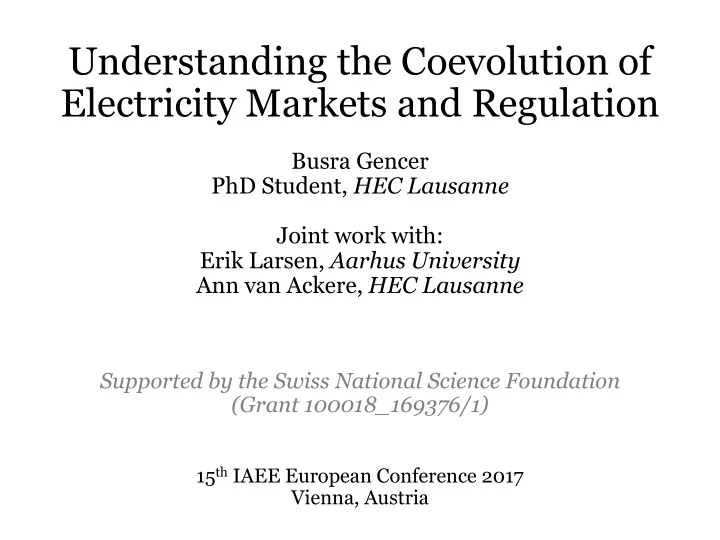

Understanding the Coevolution of Electricity Markets and Regulation Busra Gencer PhD Student, HEC Lausanne Joint work with: Erik Larsen, Aarhus University Ann van Ackere, HEC Lausanne Supported by the Swiss National Science Foundation (Grant 100018_169376/1) 15 th IAEE European Conference 2017 Vienna, Austria
Agenda • Background • Problem Statement • Relevant Literature • Elements of a Behavioral View • Future Steps 2
3
Problem Statement Regulation? Competition • High deregulated Government buying price and low Monopoly regulated selling price • Overcapacity 4
Relevant Literature • Deregulation of Electricity markets Stoft (2002), Teufel et al. (2013), Bunn & Larsen (1992), Ochoa (2007) • Type of Regulation Averch & Johnson (1962), Green & Newbery (1992), Dnes et al. (1998), Joskow (1997) • Choosing policy mechanisms Finon (2006), De Vries (2007), De Vries & Heijnen (2008) • Market characteristics Larsen & Bunn (1999), Larsen et al.(2004), Komendantova et al. (2012) • Market restructuring Vogel (1996), Larsen & Bunn (1999), Joskow (2008) • Life cycle of Regulation Bernstein (1955), Fukuyama (2008), Howlett & Newman (2013) 5
Elements of a Behavioral View Long-term horizon Dynamics Feedback Soft Behavior Stakeholders drivers 6
Evolution of Electricity Markets Problems Government Overcapacity (Europe) • Monopoly • Lack of investments (South America) Exploitation of regulated customers • Wholesale • Uncertainty competition • Disconnected wholesale and retail prices Retail competition • Market power • Lack of investments • Price volatility Mature market Lack of thermal capacity • Re- • Regulatory control regulation 7
Evolution of Electricity Markets Regulatory aims • Ensure capacity and cost recovery Government • Access Monopoly Affordability • Prevent market power • Wholesale • Protect regulated customers competition • Ensure equal access Retail competition • Prevent market power • Reach environmental targets • Ensure sufficient investments Mature market Prevent market power • Re- • Subsidies for all generation technologies to guarantee capacity regulation
Example 1: Government Monopoly Problem: Overcapacity in Europe Soft drivers Dynamics Behavior • Avoiding • Guaranteed • Ability to blackouts is cost recovery invest more the top than priority economically optimal 9
Example 2: Wholesale Competition Problem: Overcharging captive customers Dynamics Stakeholders Behavior • Competition • Powerless • Cross- drives down captive subsidization wholesale customers vs. prices larger consumers 10
Example 3: Mature Deregulated Markets Problem: Managing technological transitions Dynamics Behavior Long-term horizon • Change in • Effectiveness • Need to technology of incentives ensure from for appropriate thermal to renewables technology renewable mix 11
Example 4: Re-regulation Problem: Environmental issues Stakeholders Behavior Dynamics • Pressure from • Environmentally • Support for stakeholders driven renewables concerned about regulatory endangers the environment change economic viability of other technologies 12
To conclude… Where we are: Understanding of the evolution Inclusion of behavioral aspects Towards co-evolution rather than major overhauls Next steps: elaborate examples refine the framework 13
Understanding the Coevolution of Electricity Markets and Regulation Long- term Presenter: horizon Busra Gencer PhD Student, HEC Lausanne busra.gencer@unil.ch Dynamics Feedback Joint work with: Erik Larsen, Aarhus University Soft Behavior Stakeholders Ann van Ackere, HEC Lausanne drivers Supported by the Swiss National Science Foundation (Grant 100018_169376/1) 15 th IAEE European Conference 2017 Vienna, Austria
Recommend
More recommend